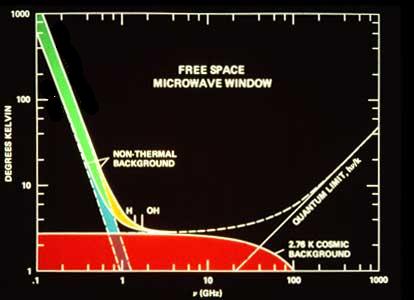Searching for Intelligent Life

The Cosmic Speed Limit
As exciting as it might sound to send manned missions in search of intelligent life,
this is an instance where one should `let their fingers do the walking'. Nothing
travels faster than the speed of light. For communicating over
typical distances between stars, we're better off doing it with light!
What kind of light should we use?
We couldn't possibly create a beacon even as bright as a star. And even if we did, we might
be overlooked as just another star! Further more, optical (visible) light is easily absorbed
and scattered (consider finding the Sun on a cloudy day). Long wavelength light is much more
efficient at passing through material it encounters (your radio picks up a signal just fine
inside a cement building).

The Microwave Region
Beyond being effective at passing through all the junk in our galaxy, the microwave
portion of the electromagnetic spectrum is the quietest in the universe. This makes
it the most ideal region of the spectrum to pick up weak, possibly very distant signals
from space. It is also the spectral region we have chosen to send out our own signals.
Choosing a Specific Frequency
It turns out that the strongest, most pervasive emission line in the universe occurs in
the microwave region. This is the spin-flip transition of neutral Hydrogen, the most
abundant element in the universe. This occurs at 1420 Megahertz (21 cm wavelength).
Broadcasting AT that exact same wavelength might not be wise. However, any intelligent
civilization would have astronomers (no?) and there for receivers tuned to this region
and aimed at the sky. If we wanted to get the attention of others, we could send a
unnaturally occurring signal pattern near this frequency.